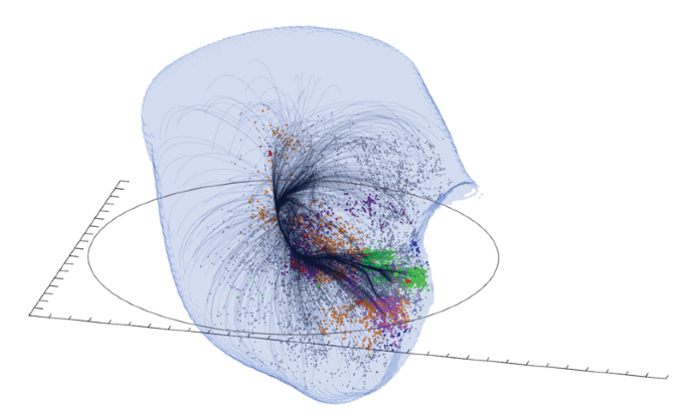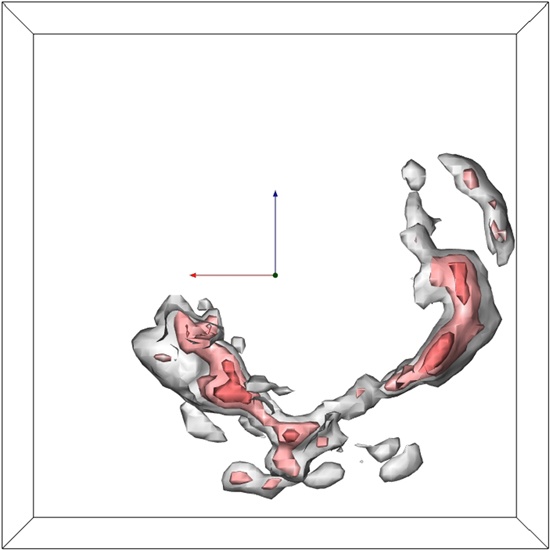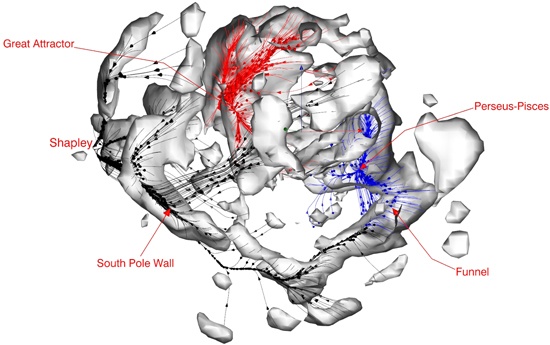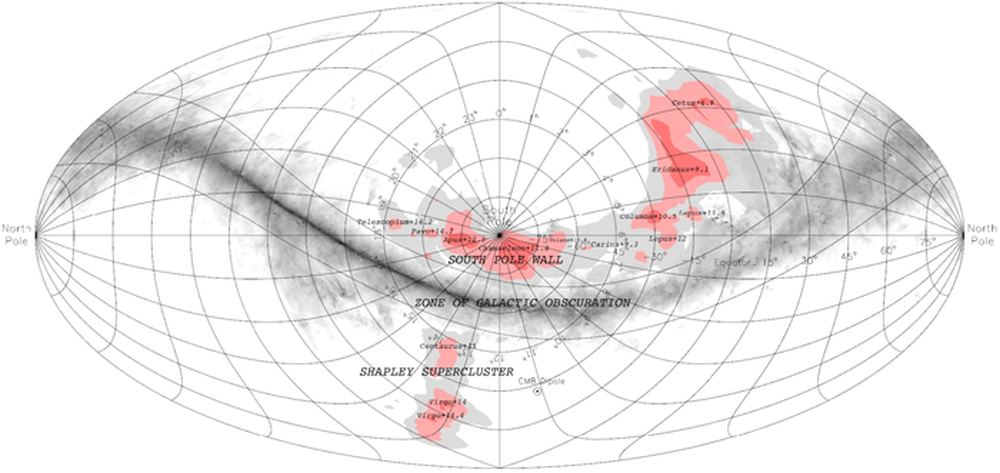Galaxies aren’t spread evenly throughout space. They exist in groups, clusters, and superclusters. Our own Milky Way galaxy exists in an impossibly vast structure called the Laniakea supercluster. Laniakea was defined in 2014, and it contains over 100,000 galaxies.
Now a team of astronomers have discovered another immense feature beyond Laniakea, called the South Pole Wall.
The South Pole Wall is like an arm wrapping around the Laniakea supercluster. The name is inspired by the Earth’s south pole. In that direction, the wall is at its thickest.
The Wall arches in a great semi-circle covering 200 degrees and reaching well into the northern sky. The concentration in the direction of the south pole is 500 million light years away, and the Wall’s extended arm to the north is 300 million light years away.
“We have found it thanks to its gravitational influence, imprinted in the velocities of a sample of galaxies.”
Daniel Pomarède, Cosmic Cartographer, and staff scientist, Institute of Research into the Fundamental Laws of the Universe.
A team of astronomers have spent a decade mapping the South Pole Wall. They’ve presented their results in a paper titled “Cosmicflows-3: The South Pole Wall.” The lead author is Daniel Pomarède, staff scientist at the Institute of Research into the Fundamental Laws of the Universe, CEA Université Paris-Saclay. Pomarède is also an expert in visualization of astronomical data and cosmography.
The paper is published in The Astrophysical Journal.

For such a large structure, the South Pole Wall has gone unnoticed for quite some time. In a press release, lead author Daniel Pomarède explained why. “One might wonder how such a large and not-so distant structure remained unnoticed. This is due to its location in a region of the sky that has not been completely surveyed, and where direct observations are hindered by foreground patches of galactic dust and clouds. We have found it thanks to its gravitational influence, imprinted in the velocities of a sample of galaxies.”
Study author Daniel Pomarède is an expert in visualizing astronomical data. In this study, he created a 3D interactive model of the South Pole Wall.

The South Pole Wall is just the latest large-scale cosmic structure astronomers have mapped out in recent history. In the last 40 years, we’ve come to understand that galaxies exist in large scale groupings. Our own Milky Way galaxy, and its satellites galaxies, are contained in a larger group of galaxies called the Local Group, a relatively small grouping of galaxies. The Local Group is in turn part of the Virgo Supercluster. And the Virgo Supercluster is just one lobe of the Laniakea supercluster.
Astronomers have also mapped out other massive features, like the Shapley Supercluster and the Great Attractor, which is the central gravitational point of the Laniakea Supercluster.
Behind the discovery of the South Pole Wall is the Cosmicflows database. Cosmicflows tries to map out the large scale structures by gathering positions and movements of thousands of galaxies. Cosmicflows-3 is the third iteration of the program, and has expanded from 8,188 entries to 17,669 entries. Some of the researchers who authored this paper also worked on Cosmicflows-3.
“We wonder if the South Pole Wall is much bigger than what we see.”
R. Brent Tully, Study Co-Author,
The galaxies in the arm aren’t static. There’s lots of movement. They move along the arm to the South Pole. From there, they move through a region obscured from our view by the Milky Way. Then, they move toward the Shapley connection, the largest structure in our neighbourhood of the Universe.
The researchers aren’t certain if what they’ve mapped so far is the entirety of the South Pole Wall. “We wonder if the South Pole Wall is much bigger than what we see,” said co-author R. Brent Tully. “What we have mapped stretches across the full domain of the region we have surveyed. We are early explorers of the cosmos, extending our maps into unknown territory,” Tully said.

The discovery of the larger scale structures of the Universe and the filamentary, clumped nature of things is one of the most interesting discoveries in recent times. Astronomers can identify these structures as their data gets better and more comprehensive. So it’s easy to wonder how accurate our current picture is, and what we’re still missing, what more there is to find.
In their paper, the authors write “Observational limitations must be acknowledged.” They then explain that the South Pole Wall was found almost at the detection limits of the Cosmicflows-3 program. “The redshift limit of this contribution is 16,000 km s?1. The South Pole Wall as we constitute it walks a constrained line inside this limit at ~13,000 km s?1.”
So the South Pole Wall is there, but it might not be all that’s there.
“The proximity of the Shapley concentration of rich clusters…” and other features “…immediately to the north of the galactic plane begs the question of what we might be missing,” the authors write.
“Given the limitations imposed by the boundaries of our study, where does the connectivity end?”
From the Paper “Cosmicflows-3: The South Pole Wall”
Even though Cosmicflows-3 contains data on twice as many galaxies as its predecessor, it still can’t contain data on everything in the region. Every study and every method has its limitations. “Given the limitations imposed by the boundaries of our study, where does the connectivity <between the South Pole Wall and other features> end?” they ask.
To be certain of the South Pole Wall’s size, and its relationship to other structures in the region will, of course, require more data. “We will not be certain of its full extent, nor whether it is unusual, until we map the universe on a significantly grander scale.”
More:
- Press Release: Astronomers map massive structure beyond Laniakea Supercluster
- Research Paper: Cosmicflows-3: The South Pole Wall
- Universe Today: Slime Mold Grows the Same as the Large Scale Structure of the Universe

